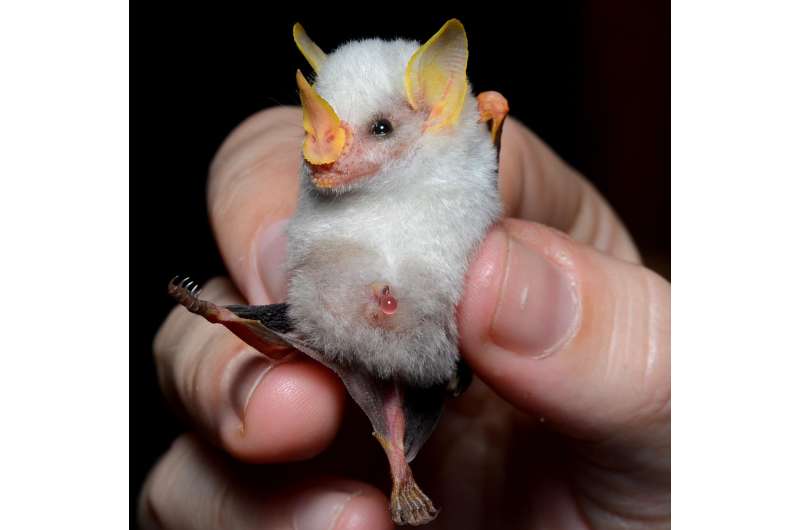October 10, 2016 report
Tropical bats found to use carotenoids for skin coloration

(Phys.org)—In the pursuit of greater carotenoid bioavailability to ensure human health, researchers have sought other animal models of carotenoid function. Recently, a collaborative of biologists in Spain and Costa Rica published the results of a study in the Proceedings of the National Academy of Sciences demonstrating that frugivorous Honduran white bats color their skin with the deposition of the carotenoid lutein—the primary carotenoid for the preservation of the macula in human eyes. This is the first time a mammal has been shown to concentrate high levels of carotenoids in skin, and thus may provide a model for the understanding and enhancement of carotenoid function.
Carotenoids are deeply colored photosynthetic pigments produced in plants, which animals use to prevent oxidative damage and to color external tissues. However, because animals can't synthesize their own carotenoids, they rely on plant dietary sources. Mammals, including humans, are particularly limited in this regard by comparison with other classes, which often have brightly colored external markings and patterns produced by carotenoids. By contrast with the brightly colored feathers and scales of birds, reptiles and fish, mammals have only small amounts of carotenoids in their skin and seemingly none in their hair.
Humans particularly rely on photosynthetic carotenoids for their provitamin A value, their immunostimulatory functions and antioxidant properties. Carotenoids are more highly concentrated in internal tissues than the skin, particularly in the macula of the eye. After consumption, carotenoids are carried through the bloodstream by lipoproteins—read dietary fats—to target tissues. Humans are thus particularly dependent on consuming dietary fat to ensure the bioavailability of carotenoids, which makes the choice between 0 percent and full-fat Greek yogurt much easier (and more delicious).
The white fruit bat's skin is a distinctive yellow, and particularly noticeable in hairless external features of the ears and nose, the integument. The researchers used high-performance liquid chromatography in combination with time-of-flight mass spectrometry in order to determine the specific carotenoid expressed in the bat's skin. They theorize that the bat's dietary source for lutein is the red ripe fruit of the Ficus colubrinae fig tree. Notably, the lutein in the skin of the bats contains esters, while their hepatic luteins were not esterified, indicating the biological ability to esterify lutein. "Although the nutritional use of xanthophylls [like lutein] may require esters to be metabolized, the fact that bats are able to esterify them into their integument opens up interesting possibilities for improving the benefits of xanthophylls to human health," the authors write.
In their report, the authors also speculate on the adaptive advantage of the bat's ability to esterify lutein in its skin. Esterified xanthophylls provide plants with stability, and the bats might receive some benefit from achieving longer-lasting skin coloration. For instance, the Honduran white fruit bat is highly social, congregating and roosting together; such gregarious behavior is highly linked with the development of distinctive visual cues like coloration for communication purposes. "Altogether," the authors conclude, "these results call into question the commonly neglected role of vision in bat communication and suggest microbats may have evolved color traits despite constraints imposed by nocturnal habitats."
More information: Tropical bat as mammalian model for skin carotenoid metabolism. PNAS (2016) DOI: 10.1073/pnas.1609724113
Abstract
Animals cannot synthesize carotenoid pigments de novo, and must consume them in their diet. Most mammals, including humans, are indiscriminate accumulators of carotenoids but inefficiently distribute them to some tissues and organs, such as skin. This limits the potential capacity of these organisms to benefit from the antioxidant and immunostimulatory functions that carotenoids fulfill. Indeed, to date, no mammal has been known to have evolved physiological mechanisms to incorporate and deposit carotenoids in the skin or hair, and mammals have therefore been assumed to rely entirely on other pigments such as melanins to color their integument. Here we use high-performance liquid chromatography (HPLC) in combination with time-of-flight mass spectrometry (HPLC-TOF/MS) to show that the frugivorous Honduran white bat Ectophylla alba colors its skin bright yellow with the deposition of the xanthophyll lutein. The Honduran white bat is thus a mammalian model that may help developing strategies to improve the assimilation of lutein in humans to avoid macular degeneration. This represents a change of paradigm in animal physiology showing that some mammals actually have the capacity to accumulate dietary carotenoids in the integument. In addition, we have also discovered that the majority of the lutein in the skin of Honduran white bats is present in esterified form with fatty acids, thereby permitting longer-lasting coloration and suggesting bright color traits may have an overlooked role in the visual communication of bats.
Journal information: Proceedings of the National Academy of Sciences
© 2016 Phys.org
















